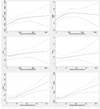Physical activity and heart rate variability in older adults: the Cardiovascular Health Study
- PMID: 24799513
- PMCID: PMC4038662
- DOI: 10.1161/CIRCULATIONAHA.113.005361
Physical activity and heart rate variability in older adults: the Cardiovascular Health Study
Abstract
Background: Cardiac mortality and electrophysiological dysfunction both increase with age. Heart rate variability (HRV) provides indices of autonomic function and electrophysiology that are associated with cardiac risk. How habitual physical activity among older adults prospectively relates to HRV, including nonlinear indices of erratic sinus patterns, is not established. We hypothesized that increasing the levels of both total leisure-time activity and walking would be prospectively associated with more favorable time-domain, frequency-domain, and nonlinear HRV measures in older adults.
Methods and results: We evaluated serial longitudinal measures of both physical activity and 24-hour Holter HRV over 5 years among 985 older US adults in the community-based Cardiovascular Health Study. After multivariable adjustment, greater total leisure-time activity, walking distance, and walking pace were each prospectively associated with specific, more favorable HRV indices, including higher 24-hour standard deviation of all normal-to-normal intervals (Ptrend=0.009, 0.02, 0.06, respectively) and ultralow-frequency power (Ptrend=0.02, 0.008, 0.16, respectively). Greater walking pace was also associated with a higher short-term fractal scaling exponent (Ptrend=0.003) and lower Poincaré ratio (Ptrend=0.02), markers of less erratic sinus patterns.
Conclusions: Greater total leisure-time activity, and walking alone, as well, were prospectively associated with more favorable and specific indices of autonomic function in older adults, including several suggestive of more normal circadian fluctuations and less erratic sinoatrial firing. Our results suggest potential mechanisms that might contribute to lower cardiovascular mortality with habitual physical activity later in life.
Keywords: electrophysiology; epidemiology; exercise; heart rate; motor activity.
© 2014 American Heart Association, Inc.
Conflict of interest statement
Figures



Comment in
-
Exercise, heart rate variability, and longevity: the cocoon mystery?Circulation. 2014 May 27;129(21):2085-7. doi: 10.1161/CIRCULATIONAHA.114.009778. Epub 2014 May 5. Circulation. 2014. PMID: 24799512 No abstract available.
-
Letter by Monfredi et al regarding article, "Physical activity and heart rate variability in older adults: the cardiovascular health study".Circulation. 2015 Feb 17;131(7):e348. doi: 10.1161/CIRCULATIONAHA.114.011515. Circulation. 2015. PMID: 25691708 No abstract available.
-
Response to letter regarding article, "physical activity and heart rate variability in older adults: the cardiovascular health study".Circulation. 2015 Feb 17;131(7):e349-50. doi: 10.1161/CIRCULATIONAHA.114.012825. Circulation. 2015. PMID: 25691709 No abstract available.
Similar articles
-
Dietary fish and omega-3 fatty acid consumption and heart rate variability in US adults.Circulation. 2008 Mar 4;117(9):1130-7. doi: 10.1161/CIRCULATIONAHA.107.732826. Epub 2008 Feb 19. Circulation. 2008. PMID: 18285566
-
Trans-fatty acid consumption and heart rate variability in 2 separate cohorts of older and younger adults.Circ Arrhythm Electrophysiol. 2012 Aug 1;5(4):728-38. doi: 10.1161/CIRCEP.111.966259. Epub 2012 Jul 6. Circ Arrhythm Electrophysiol. 2012. PMID: 22772898 Free PMC article.
-
Response to letter regarding article, "physical activity and heart rate variability in older adults: the cardiovascular health study".Circulation. 2015 Feb 17;131(7):e349-50. doi: 10.1161/CIRCULATIONAHA.114.012825. Circulation. 2015. PMID: 25691709 No abstract available.
-
Chronomics for chronoastrobiology with immediate spin-offs for life quality and longevity.Biomed Pharmacother. 2003 Oct;57 Suppl 1:1s-18s. doi: 10.1016/j.biopha.2003.08.018. Biomed Pharmacother. 2003. PMID: 14572671 Review.
-
[Heart rate variability and physical exercise. Current status].Herz. 2006 Sep;31(6):544-52. doi: 10.1007/s00059-006-2855-1. Herz. 2006. PMID: 17036185 Review. German.
Cited by
-
Central markers of obesity affect heart rate variability independent of physical activity in young adults.J Family Med Prim Care. 2022 Jun;11(6):2521-2525. doi: 10.4103/jfmpc.jfmpc_1970_21. Epub 2022 Jun 30. J Family Med Prim Care. 2022. PMID: 36119331 Free PMC article.
-
Exercise and Arterial Modulation in Children: The EXAMIN YOUTH Study.Front Physiol. 2019 Feb 1;10:43. doi: 10.3389/fphys.2019.00043. eCollection 2019. Front Physiol. 2019. PMID: 30774601 Free PMC article.
-
Association between cardiac autonomic function and physical activity in patients at high risk of sudden cardiac death: a cohort study.Int J Behav Nutr Phys Act. 2021 Sep 20;18(1):128. doi: 10.1186/s12966-021-01200-0. Int J Behav Nutr Phys Act. 2021. PMID: 34544427 Free PMC article.
-
Effects of weight loss and weight loss maintenance on cardiac autonomic function in obesity: a randomized controlled trial.Appl Physiol Nutr Metab. 2023 Sep 1;48(9):678-691. doi: 10.1139/apnm-2023-0025. Epub 2023 May 25. Appl Physiol Nutr Metab. 2023. PMID: 37229779 Free PMC article. Clinical Trial.
-
Exercise, Physical Activity, and Cardiometabolic Health: Insights into the Prevention and Treatment of Cardiometabolic Diseases.Cardiol Rev. 2022 Jul-Aug 01;30(4):167-178. doi: 10.1097/CRD.0000000000000416. Epub 2021 Sep 15. Cardiol Rev. 2022. PMID: 34560712 Free PMC article.
References
-
- Tsuji H, Venditti FJ, Jr, Manders ES, Evans JC, Larson MG, Feldman CL, Levy D. Reduced heart rate variability and mortality risk in an elderly cohort. The framingham heart study. Circulation. 1994;90:878–883. - PubMed
-
- Heart rate variability: Standards of measurement, physiological interpretation and clinical use. Task force of the european society of cardiology and the north american society of pacing and electrophysiology. Circulation. 1996;93:1043–1065. - PubMed
-
- Saffitz JE. Sympathetic neural activity and the pathogenesis of sudden cardiac death. Heart Rhythm. 2008;5:140–141. - PubMed
-
- Vanoli E, De Ferrari GM, Stramba-Badiale M, Hull SS, Jr, Foreman RD, Schwartz PJ. Vagal stimulation and prevention of sudden death in conscious dogs with a healed myocardial infarction. Circ Res. 1991;68:1471–1481. - PubMed
Publication types
MeSH terms
Grants and funding
- N01 HC085080/HL/NHLBI NIH HHS/United States
- N01HC85239/HC/NHLBI NIH HHS/United States
- U01 HL080295/HL/NHLBI NIH HHS/United States
- N01 HC085082/HL/NHLBI NIH HHS/United States
- HHSN268201200036C/HL/NHLBI NIH HHS/United States
- N01 HC055222/HL/NHLBI NIH HHS/United States
- N01 HC085079/HL/NHLBI NIH HHS/United States
- R01 HL080295/HL/NHLBI NIH HHS/United States
- HL080295/HL/NHLBI NIH HHS/United States
- R01 AG023629/AG/NIA NIH HHS/United States
- N01 HC085081/HL/NHLBI NIH HHS/United States
- N01 HC55222/HC/NHLBI NIH HHS/United States
- N01 HC085086/HL/NHLBI NIH HHS/United States
- N01 HC085083/HL/NHLBI NIH HHS/United States
- AG023629/AG/NIA NIH HHS/United States
- R56 AG023629/AG/NIA NIH HHS/United States
LinkOut - more resources
Full Text Sources
Other Literature Sources

